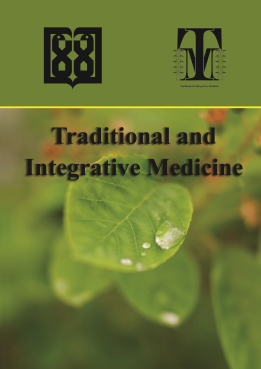2024 CiteScore: 1.4
pISSN: 2476-5104
eISSN: 2476-5112
Chairman:
Hossein Rezaeizadeh, MD, PhD.
Editor-in-Chief:
Roja Rahimi, PharmD, PhD.
Vol 5, No 3, 2020
No Abstract
Drinking ice-cold water is prohibited in Avicenna’s “The Canon of Medicine” book in which he emphasized that ice-cold water drinking was hazardous for the body organs such as the liver. Little information can be found regarding the effects of ice-cold fluid drinks on liver and its probable sequels on this vital organ. Accordingly, we investigated the effects of long-term ice-cold water drink on the rat liver function and histology. Eighteen male Wistar rats, weighing 180±20 g, were randomly divided into three groups of six as two months ice-cold water drink, CW2M; three months ice-cold water drink, CW3M; and three months room temperature water drink; control group. Upon completion of the care period, a blood sample has been taken for liver enzymes and lipid profile assessment. Liver tissue has also been used for histological studies of H&E staining and microscopic examination. Histological findings showed hepatocellular micro-vesicle formation, necrosis and derangement of the cellular cords and infiltration of Kupffer cells in ice-cold water taken animals. Serum TGs, VLDL-C and ALP significantly increased with sound decrease in FBS and LDL-C in ice-cold water taken animals. It seems that long-term ice-cold water has deleterious functional and structural effects on the liver.
Dysmenorrhea is known as painful menstruation with considerable effects on women's mental status and quality of life with some limits for treatment. The objective of this prospective case series was to evaluate effects of Saussurea Costus (Qost) oil, an Iranian Traditional Medicine (Persian Medicine) product, on the primary dysmenorrhea. In this case series, 13 patients were included to study and treated with local Qost oil for 6 weeks. The oil was rubbed (without massage) 15 drops every 12 hours to the sub-navel region until pubis. The improvement of dysmenorrhea, evaluated with VAS score based on the last periodic cycle before the study and the last cycle after the completion of the intervention, which continued 6 weeks (at least one period for each patient). Then, 4 weeks after the end of the intervention (equivalent to one period for each patient), the evaluation was performed. The mean VAS score of patients before intervention was 7.77. The score after the end of intervention up to 4 weeks after the end of intervention improved to 1.85. (76.191%). During this study, no side effects were reported in the patients, and no patient was excluded from the study. Due to easiness of use and low invasion of topical treatment, it can be suitable for dysmenorrhea controlling. Upon the beneficial effects of Qost oil on uterine diseases and pains in Persian Medicine sources, usage of that oil in double blinded clinical trial in the subject of dysmenorrhea is suggested.
In addition to respiratory symptoms as the most common manifestations of COVID-19, GI tract symptoms may occur in some patients, as well. These symptoms could be disabling and annoying and supportive treatments are required to control them. Some natural remedies based on Persian medicine could be effective to fast control of GI manifestations of COVID-19 disease through Food modification and using some medicinal plants and Life style correction. This paper reports a case of COVID-19 patient with GI complications which has been treated by using Persian Medicine recommendations.
Rheumatic diseases such as osteoarthritis (OA), rheumatoid arthritis (RA), and low back pain are very popular. The drugs available to treat these diseases are almost ineffective and have significant side effects. There are several approaches used to replace conventional drugs to treat these diseases. One of these methods is the use of herbal medicines. In this study, the effects of herbal medicines and medicinal plants used in the treatment of these diseases include. Searching for articles published in English from 1985 to 2020 using keywords include scientific and traditional names of plants reviewing Scopus and PubMed databases. There is limited research on the anti-rheumatic effects of these plants and the active ingredients. Therefore, further research is needed to determine the mechanism of action, the interaction of effects, the efficacy and safety of medicinal plants, and the potentially beneficial plant nutrients in treatment of these diseases seems necessary. The aim of this review was to update information on OA and chondrogenesis, also importance of herbal drugs for the management of arthritis.
Bunium persicum (Boiss) B. Fedtsh (Apiaceae, Persian name: Zireh Kermani) has been used to treat various diseases in traditional and folkloric medicine including gastrointestinal, respiratory, nasopharyngeal, cardiac, ocular, neurological, rheumatological and urinary tract diseases. Its essential oil contains different monoterpenes, sesquiterpenes and phenyl propenes. Other chemical constituents identified in B. persicum are phenolic compounds, fatty acids, carboxylic acids, and carbohydrates. Wide range of biological and pharmacological activities including antioxidant, analgesic, anti-inflammatory, acetylcholinesterase inhibitory, anticonvulsant, HMG-CoA reductase inhibitory, anti-pancreatic lipase, anticancer, antidiabetic, antihistamine, antidiarrheal, antispasmodic, antihematoxic, antityrosinase and antimicrobial activities have been reported from this plant in modern medicine. This article summarizes comprehensive information attributing traditional uses, phytochemistry, and pharmacological activities of Zireh Kermani.
2024 CiteScore: 1.4
pISSN: 2476-5104
eISSN: 2476-5112
Chairman:
Hossein Rezaeizadeh, MD, PhD.
Editor-in-Chief:
Roja Rahimi, PharmD, PhD.



 |
All the work in this journal are licensed under a Creative Commons Attribution-NonCommercial 4.0 International License. |
